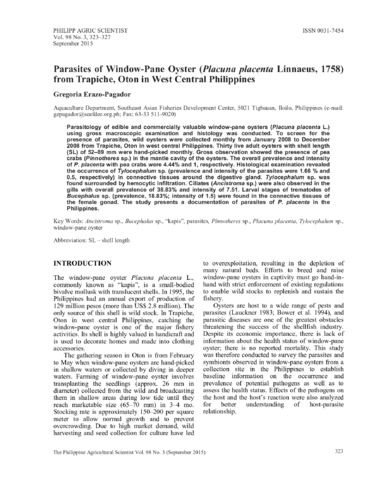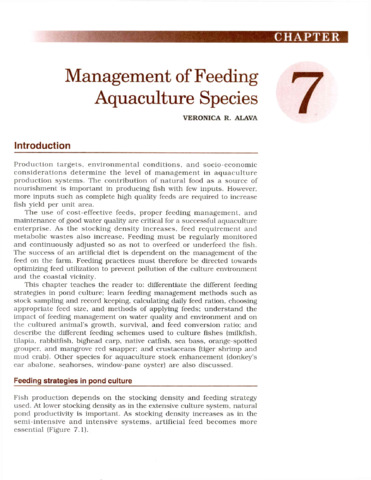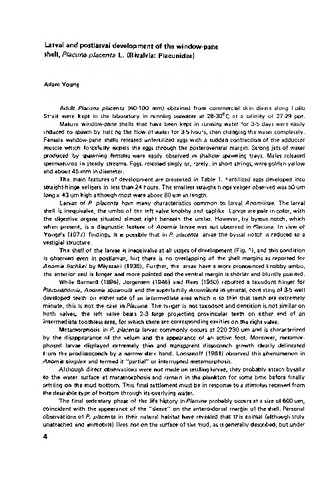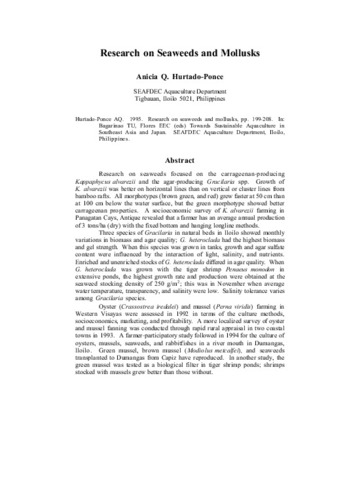Parasites of window-pane oyster (Placuna placenta Linnaeus, 1758) from Trapiche, Oton in west central Philippines
- Global styles
- MLA
- Vancouver
- Elsevier - Harvard
- APA
- Help

View/Open
Date
2015Author
Page views
995ASFA keyword
AGROVOC keyword
Taxonomic term
Metadata
Show full item recordShare
Abstract
Parasitology of edible and commercially valuable window-pane oysters (Placuna placenta L.) using gross macroscopic examination and histology was conducted. To screen for the presence of parasites, wild oysters were collected monthly from January 2008 to December 2008 from Trapiche, Oton in west central Philippines. Thirty live adult oysters with shell length (SL) of 52-89 mm were hand-picked monthly. Gross observation showed the presence of pea crabs (Pinnotheres sp.) in the mantle cavity of the oysters. The overall prevalence and intensity of P. placenta with pea crabs were 4.44% and 1, respectively. Histological examination revealed the occurrence of Tylocephalum sp. (prevalence and intensity of the parasites were 1.66 % and 0.5, respectively) in connective tissues around the digestive gland. Tylocephalum sp. was found surrounded by hemocytic infiltration. Ciliates (Ancistroma sp.) were also observed in the gills with overall prevalence of 38.83% and intensity of 7.51. Larval stages of trematodes of Bucephalus sp. (prevalence, 18.83%; intensity of 1.5) were found in the connective tissues of the female gonad. The study presents a documentation of parasites of P. placenta in the Philippines.
Suggested Citation
Erazo-Pagador, G. (2015). Parasites of window-pane oyster (Placuna placenta Linnaeus, 1758) from Trapiche, Oton in west central Philippines. The Philippine Agricultural Scientist , 98(3), 323-327. http://hdl.handle.net/10862/3044
Type
ArticleISSN
0031-7454Collections
- Journal Articles [1249]
Related items
Showing items related by title, author, creator and subject.
-
Management of feeding aquaculture species
Alava, Veronica R. (Aquaculture Department, Southeast Asian Fisheries Development Center, 2002)This chapter teaches the reader to: differentiate the different feeding strategies in pond culture; learn feeding management methods such as stock sampling and record keeping, calculating daily feed ration, choosing ... -
Larval and postlarval development of the window-pane shell, Placuna placenta L. (Bivalvia: Placunidae)
Young, Adam (Aquaculture Department, Southeast Asian Fisheries Development Center, 1979)Stages of development of P. placenta from the straight-hinge veliger to the adult are described. Mature larvae metamorphose at lengths from 220-230 m. Larvae probably attach byssally to the water surface at metamorphosis ... -
Research on seaweeds and mollusks
Hurtado-Ponce, Anicia Q. (Aquaculture Department, Southeast Asian Fisheries Development Center, 1995)Research on seaweeds focused on the carrageenan-producing Kappaphycus alvarezii and the agar-producing Gracilaria spp. Growth of K. alvarezii was better on horizontal lines than on vertical or cluster lines from bamboo ...





